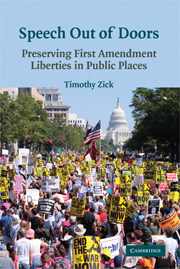Book contents
- Frontmatter
- Contents
- List of Figures
- Preface
- Acknowledgments
- SPEECH OUT OF DOORS
- 1 Introduction: The Geography of Expression
- 2 The Expressive Topography and Public Liberties
- 3 Embodied Places
- 4 Contested Places
- 5 Non-Places
- 6 Inscribed Places
- 7 Militarized Places
- 8 Places of Higher Learning
- 9 Networked Public Places
- Epilogue
- Index
- References
9 - Networked Public Places
Published online by Cambridge University Press: 05 June 2012
- Frontmatter
- Contents
- List of Figures
- Preface
- Acknowledgments
- SPEECH OUT OF DOORS
- 1 Introduction: The Geography of Expression
- 2 The Expressive Topography and Public Liberties
- 3 Embodied Places
- 4 Contested Places
- 5 Non-Places
- 6 Inscribed Places
- 7 Militarized Places
- 8 Places of Higher Learning
- 9 Networked Public Places
- Epilogue
- Index
- References
Summary
This final chapter examines a phenomenon that will substantially affect the expressive topography as we move into the twenty-first century. Today, many public places are being transformed into networked places. Local communities, perhaps soon entire states, will be blanketed with public and private wireless Internet “clouds” or “meshes.” In many cases these wireless networks will be linked to substantial surveillance systems. According to a recent study, there are currently more than 4,000 video cameras blanketing lower Manhattan. This is a five-fold increase from 1998. There will soon be many more. The New York City Police Department plans to implement a “Ring of Steel” around the financial district comparable to that erected by authorities in London in the 1990s. These powerful machines are able to see from a distance, and record, details as small as the lettering on a pack of cigarettes. Finally, when in public places, people are increasingly carrying or wearing sophisticated mobile technologies, including pervasive personal computing devices like multifeature cell phones and personal digital assistants. In sum, networking is a top-to-bottom technological transformation of public places.
As some scholars have noted, the networking of public places will raise serious Fourth Amendment concerns regarding searches and privacy. But it will raise less-noted First Amendment issues as well. Indeed, spatial networking ought to be added to the host of forces – privatization of public space, architectural revisions, legal restrictions on public displays of contention, public order management regimes, and “militarization” – that substantially affect the amount of breathing space available for the exercise of First Amendment liberties.
- Type
- Chapter
- Information
- Speech Out of DoorsPreserving First Amendment Liberties in Public Places, pp. 294 - 324Publisher: Cambridge University PressPrint publication year: 2008



